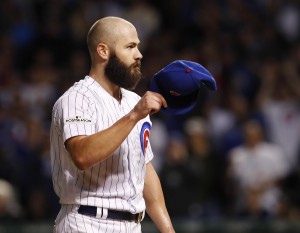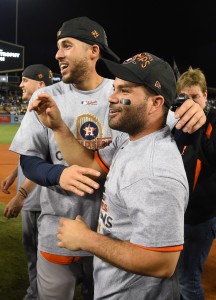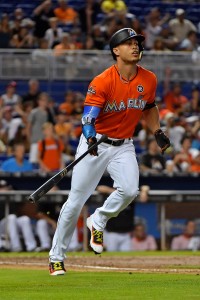MLBTR is publishing Offseason Outlooks for all 30 teams. Click here for the other entries in this series.
The Red Sox are looking to add pieces for not just another trip to the postseason, but a deep march into October under new manager Alex Cora.
Guaranteed Contracts
- David Price, SP: $157MM through 2022 (can opt out after 2018)
- Dustin Pedroia, 2B: $56MM through 2021
- Rick Porcello, SP: $42MM through 2019
- Rusney Castillo, OF: $35.5MM through 2020 (can opt out after 2019)
- Hanley Ramirez, 1B/DH: $22MM through 2018 ($22MM option for 2019 vests if Ramirez makes 497 plate appearances in 2018 and passes a physical after the season)
- Craig Kimbrel, RP: $13MM through 2018
- Chris Sale, SP: $12.5MM through 2018 ($15MM club option for 2019 with $1MM buyout)
Obligations To Former Players
- Pablo Sandoval, 3B: $41MM through 2019 (includes buyout of 2020 club option), minus prorated MLB minimum salaries earned by Sandoval in that span
Arbitration Eligible Players (service time in parentheses; projections via MLBTR contributor Matt Swartz)
- Joe Kelly (5.029) – $3.6MM
- Drew Pomeranz (5.013) – $9.1MM
- Tyler Thornburg (4.057) – $2.1MM
- Brock Holt (4.052) – $2.0MM
- Xander Bogaerts (4.042) – $7.6MM
- Jackie Bradley Jr. (3.150) – $5.9MM
- Sandy Leon (3.149) – $2.1MM
- Steven Wright (3.089) – $1.2MM
- Mookie Betts (3.070) – $8.2MM
- Brandon Workman (3.036) – $900K
- Christian Vazquez (3.031) – $1.5MM
- Carson Smith (3.028) – $1.1MM
- Eduardo Rodriguez (2.130) – $2.7MM
- Non-tender candidates: Holt, Leon
Free Agents
- Addison Reed, Eduardo Nunez, Mitch Moreland, Chris Young, Rajai Davis, Doug Fister, Blaine Boyer, Fernando Abad, Robbie Ross, Josh Rutledge
Boston Red Sox offseason page | Boston Red Sox payroll information
John Farrell’s job security was a topic of speculation basically from the moment Dave Dombrowski was hired as the Red Sox president of baseball operations in August 2015. Despite division titles in each of the last two years, Boston’s early exits in the ALDS finally sealed Farrell’s fate, paving the way for Cora’s hiring. The former Astros bench coach is an intriguing hire, bringing both an appreciation for analytics and a wealth of in-game experience from his 11-year playing career. Cora only has one year of MLB coaching duty under his belt, though he received interest in past managerial openings even before his stint in Houston.
A fresh voice in the dugout may be what is required for a Red Sox team that, despite the AL East title, seemed to almost take a step backwards in 2017 thanks to an inconsistent offense and some ongoing injury problems that will extend into the 2018 season. Dombrowski’s first two offseasons in Boston largely consisted of a few blockbuster moves (i.e. the David Price signing, the trades for Chris Sale and Craig Kimbrel) seen as final touch-type of acquisitions for a team that already has so much core talent in place. It wouldn’t be surprising to see the Sox make another headline-grabbing transaction to address weak spots on the roster.
Some type of infield depth would seem to be a need given that Dustin Pedroia will be out of action until at least late May or early June due to knee surgery. Some combination of Marco Hernandez, Deven Marrero, Tzu-Wei Lin, and (if he returns) Brock Holt could fill in until Pedroia is ready, though relying on internal options for a third of the season is risky, not to mention the fact that Pedroia may not be 100 percent when he does return.
A reunion with Eduardo Nunez could be an answer to this problem, as Nunez could play second base until Pedroia is back, and then shift into a utility role. Nunez is going to be in high demand this offseason with teams that could offer him everyday playing time, however, as Nunez doesn’t have much of a path to regular at-bats in Boston with Pedroia (eventually), Xander Bogaerts, Rafael Devers, Mookie Betts, Andrew Benintendi, and Jackie Bradley Jr. all locked into regular duty around the diamond.
Of course, that assumes that the Sox wouldn’t trade from that core to address another need. Bradley has often been cited as the most expendable member of Boston’s starting outfield, and with Benintendi capable of shifting over to handle center field, Bradley could be dealt for a heavy-hitting first baseman or left fielder.
Power is a clear priority for the Red Sox this winter, coming off a year that saw Boston hit fewer homers than all but three other teams in baseball. A full season for Devers will help in this department, as will Betts and Bogaerts recovering from nagging thumb and wrist injuries, though the simplest solution might be to just add a big bopper in free agency or via trade.
Eric Hosmer or Carlos Santana will get some attention from the Red Sox this winter in the free agent first base market, plus possible trade candidates like Jose Abreu also figure to be on the radar. If the Sox don’t want to make quite that big a splash, Logan Morrison or Yonder Alonso stand out as second-tier options.
Since prospect Sam Travis is still in the picture and Hanley Ramirez could see more action at first after undergoing shoulder surgery, the Sox could look for a first baseman on a shorter-term deal, akin to their signing of Mitch Moreland last offseason. That said, Boston figures to be looking for more than a band-aid solution at first base. Ramirez may be close to being a full-time DH at this point in his career, and Travis only had a so-so 2017 after missing much of 2016 due to knee surgery.
One creative answer would be to sign Alex Avila — a left-handed hitting catcher who has some first base experience. Avila could then spell both Travis/Ramirez at first, and also Christian Vazquez behind the plate. Vazquez brings outstanding defense and he took a notable step forward at the plate in 2017, but is still a below-average hitter overall. Adding Avila into a timeshare situation at multiple positions would allow the Red Sox to boost their lineup while still retaining Vazquez as an important regular. Such a move would necessitate letting Sandy Leon go, though he regressed badly after his seeming breakout in the 2016 season.
If a Bradley trade scenario happens, that opens up left field and the possibility of J.D. Martinez in Boston. Martinez is the top free agent bat available this offseason and he has past ties to Dombrowski from their days together with the Tigers. The trade market also holds out some potential for adding power to the corner outfield, with Andrew McCutchen of the Pirates and Giancarlo Stanton of the Marlins among the possibilities. It isn’t clear if Stanton would waive his no-trade protection to approve a deal to Boston, though the Red Sox are one of the few teams with the financial means to absorb the $295MM owed to Stanton through 2027. (There’s also a chance Boston’s hypothetical commitment wouldn’t last that long, as Stanton can opt out of his deal after the 2020 season.) A Stanton/Red Sox trade could also see the Marlins take on a big Sox salary or two in return to help offset Stanton’s cost — this could be a way for the Red Sox to get Rusney Castillo’s contract off the books, for instance — though Miami’s goal seems to be to shed as much salary as possible.
Dangling Bradley in a trade would not just clear space, of course. Trading a player of his ability wouldn’t be undertaken lightly, even if it was done to make way for a new star. The market would likely pay quite a bit for Bradley even after a down 2017 season, which might allow the Sox to recoup prospect assets and/or address other needs on the roster.
Adding another big salary would push the Sox back over the luxury tax threshold, though as Dombrowski bluntly stated to reporters, this doesn’t appear to be a big concern. Avoiding the tax might’ve been unavoidable anyway (as Alex Speier of the Boston Globe recently observed) given the team’s needs. This will have the effect of limiting what the Red Sox could potentially do next offseason when multiple superstars hit the free agent market, though it could be argued that the Sox now have the opportunity to more aggressively shop for talent this winter if other big-market teams are curbing their spending in preparation for next winter.
On the pitching side, the Sox bullpen was quietly a major strength for the team last year, and should continue to be a plus even if Addison Reed, Fernando Abad, and Blaine Boyer all leave in free agency. (The club has already parted ways with Robbie Ross after his injury-plagued year.) These departures could be filled from within if Carson Smith and Tyler Thornburg are finally healthy, plus youngsters Austin Maddox or Williams Jerez could be ready for some steady big league exposure.
Dombrowski has made a point of trading for relievers in his first two offseasons in Boston, so a new bullpen arm may be more likely to come via the trade market than free agency. Then again, with the major exception of the Kimbrel deal, the Sox haven’t gotten much return on those reliever trades, so Dombrowski could switch tactics and look to the open market for upgrades. The precise approach may depend upon how Boston ends up addressing the primary needs discussed above. Expect a focus on southpaws, as the pen is short on proven left-handed relievers.
The rotation could potentially also be an area of need, depending on how some injury situations progress during the spring. David Price is hoping to be finally past the elbow problems limited him to just 74 2/3 IP last season, Steven Wright is returning from knee surgery that cost him almost all of 2017, and Eduardo Rodriguez will already be sidelined for until May or even June as he recovers from his own knee surgery. Assuming Price and Wright are both fully recovered, the Red Sox face a possible “good problem to have” starter surplus when Rodriguez gets back.
If more health uncertainty develops during the offseason or in Spring Training, however, the Sox will check in on veteran starters for depth. Unless a longer-term injury crops up, the team isn’t likely to pursue anything beyond innings-eating veteran options. Dombrowski mentioned last winter how he had a tough time attracting pitchers due to the number of other starting options already on Boston’s roster, and, barring a trade, the same is true of the 2018 staff.
There is no shortage of potential moves, big or small, that could fit for the Red Sox this offseason, and Dombrowski has certainly shown his willingness to make some bold transactions. It could be that Cora and a healthier lineup are the real “final pieces” the Sox need to challenge for a World Series next year, though it seems likely that one more star name will find his way to Fenway Park before Opening Day.



